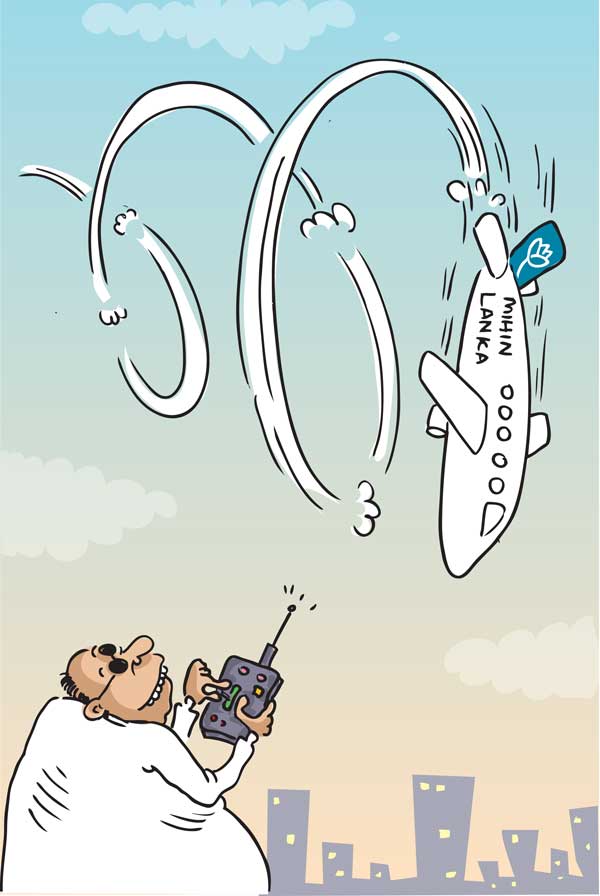04 Nov 2016 - {{hitsCtrl.values.hits}}

It appeared in the newspapers that the government has decided to close down Mihin. I confess that I do not know what the profit/loss books say about Mihin and its operation. Yet, I do know a thing or  two about aeroplanes and airlines. I mean no disrespect to anyone at Mihin or SriLankan (UL) as my criticism is aimed directly at the political nonsense that has ruined aviation in Sri Lanka, which made me decide to at least voice my concerns without sinning in silence.
two about aeroplanes and airlines. I mean no disrespect to anyone at Mihin or SriLankan (UL) as my criticism is aimed directly at the political nonsense that has ruined aviation in Sri Lanka, which made me decide to at least voice my concerns without sinning in silence.
The million-dollar question is who in the government decided to shut down Mihin? Was it the president? I do not think so. Was it the prime minister? May be. Was it the aviation minister? Could be. Very reliable information tells me the current management of UL recommended the closing of Mihin. They would have had their professional reasons to do so to find an answer to a huge financial problem they inherited by taking on Mihin. But a request to close Mihin sure would have poured honey on the ‘Yahapalana’ ears as nothing would please them more than shutting down something that the previous government started. Right or wrong? Let’s have a look.
Mihin has been losing money from 2007. Four aeroplanes and 12 routes were Mihin’s operation and it has now been taken over by UL. Some staff too. UL is losing billions. So, how does an airline that loses billions take a small fry of four aeroplanes and 12 routes and make it profitable when the cost per available seat mile (CASM) of UL is way beyond that of Mihin? Does that make any sense?
This was a pure political decision to merge and there is absolutely no doubt that it came directly from ‘Diyawanna Oya’. Of course the current UL management inherited Mihin (or got it shoved down their throat) with all its multiple burdens. Bad enough they had their hands full with resurrecting UL. They were given an additional burden of ‘what shall we do with Mihin?
UL would have done its homework and seen the mire Mihin was in. Having looked at various options and having found no answer, it may have sought the blessings of the current powers to close Mihin. Nobody was there to defend a ‘has been’ orphan, especially when it was fathered by
yesterday’s powers.
All political
And so Mihin got blasted off the sky, proposed by the UL management and delightfully decided by ‘Diyawanna Oya’. In my humble opinion, I think they killed a goose that possibly could have laid some golden eggs. Shutting down Mihin said good bye to the vast low-cost market in Sri Lanka and the region. The merits of converting all that into a legacy airline that is struggling financially, is difficult to understand. With 11 new regional destinations opening up for UL, I cannot see how there could not have been a place for a low-cost operation.
Mihin had everything in place except reasonably leased aeroplanes with matching engines and low-cost seating. That transformation could have cost money but wouldn’t it have been a better option than a total shut down? Forget the four aeroplanes, two would have been a beginning – single aisle A320s with CFM engines flying a low-cost flag. Let us not forget that UL began with two second-hand moth-balled 707s from Singapore Airlines.
Let’s go for some simple explanation. UL is a national carrier and it sure needs to have some status and standing. It has to be five-star class with all the trimmings that go with it. The problem at UL has been that during most of its lifetime politicians in power have used it as their grand-mother’s dowry. Overstaffed beyond the brim to oblige political requests, wrong aeroplanes ordered by politics, decision-makers appointed by politics and told what to do by politics. No wonder it lost so much money.
Mihin was supposed to be a low-cost airline. A simple ‘kotthu roti kade’ compared to UL’s five-star flamboyance. Then came the politics. Mihin was correctly visioned, hurriedly launched and badly managed and the losses stampeded while sliding down a slippery slope. None of this happened because of the working staff. They toiled as best as they could and gave committed service to the company making a valiant effort to keep it afloat.
The ruination came from the big guns appointed by political powers whose commercial decisions were more to do with what they were ordered to do than what was profitable for the airline. They wet-leased miss-matched aeroplanes from wrong leasing houses at exorbitant prices that had question marks flashing in neon. But who to ask? It was all political, too powerful for anyone to question. That’s what originally killed Mihin Air! Of course when simplified, the big guns did things to please the powers that were of yesterday.
Low-cost syndrome
Let’s get back to my ‘kotthu roti’ story. The problem with Mihin was it should have stuck to selling ‘kotthu roti’, that is the low-cost concept. Unfortunately, all that was changed. Metaphorically, they made it fancy, air-conditioned and valet parking and five-star type chefs for the ‘kotthu kade’. No wonder they lost the plot. Mihin became a low-cost airline with a Business Class and serving menu card meals; it is sad, no, better word is disastrous. But one must remember this too was part of the grandmother’s dowry. How could the ‘powers that be’ travel in economy discomfort? I saw Mihin billboards advertising ‘now our Business Class seats are two inches more in width’, as if anyone travelling low-cost airlines cared how wide a seat was. Passengers only worry about the price and the safety of the flight. ‘Pack them like sardines’ – that is the motto of the low-cost world. With all this political tomfoolery the airline was sprinting to be in the ‘red’.
Somebody should have had the sense to cut the cost down and strip the fancy livery and go ‘lean and mean’ to operate emulating the model of best-run low-cost airlines. Do not go far, just take a good look at Indigo in India, brand-new A320s, 115 aeroplanes, very well managed and making profits. Indigo started only in 2006, one year earlier than Mihin. How did it do so well? Simple – no politics, it is privately owned and professionally run. Forget Indigo, Jet Airways and Spice Jet too
made profits.
And so Mihin lost money. Has it declared bankruptcy? No. Did anyone make any genuine effort to plug the leaks and make it float? No. Don’t forget Mihin in its seven-plus years of operation did not place a simple piece of sticking plaster on a single passenger. The safety record is excellent. It is the financial record that is putrid, a direct result of
political management.
So, let’s take the current situation. Twelve sectors and four aeroplanes taken over by UL and they have closed Mihin. What it really means to the average you and me is that they are closing the ‘kotthu kade’ to make it a five-star restaurant and losing the ‘kotthu roti’ customers.
You do not need big talk and big plans and bigger money commitment to run a low-cost airline. You need spirit – the kind that spreads from the captain to the cleaner and from head honcho to the minion. And you need a non-political dynamic leadership of people who know what they are talking about in the aeroplane world. That then would be a horse you can bet on.
Mihin has been shot down by politics. Who knows? I may sound silly, but sillier things have come out of ‘Diyawanna Oya’ to the utter amazement of people with sense. May be someone in a high place whispered to another someone in a higher place and alerted that if Mihin is turned around and does well, it might be a feather in the cap for the powers that were. After all, they hatched the baby. But if Mihin is killed, nobody will ask, “Who killed Cock Robin? I, said the Sparrow, With my bow and arrow,” so goes the nursery rhyme. After all, political Sri Lanka always assumed the proletariat came from the kindergarten.
It was a government decision to put right what the others have done wrong. So let’s kill Mihin.
I wish a day will dawn when a proper low-cost airline starts operating from Colombo. We, Sri Lankans, are definite fans of the low-cost syndrome. Legacy airlines are costly and today’s passenger is an ardent fan of the low-cost concept. That is why the big boys have little low-cost siblings. Singapore Airlines runs three low-cost airlines – Scoot, Tiger and Vistara. Cathy has Dragon, Qantas has Jet Star, Thai has Thai Smiles, Emirates has Fly Dubai and we did have Mihin. But then, it is now
in oblivion!!
(Capt. Elmo Jayawardena was a former Chief Pilot of UL, an instructor Captain with Singapore Airlines (SIA) and currently trains pilots for Boeing in its campus in Singapore. He can be contacted via [email protected])
10 Jan 2025 10 minute ago
10 Jan 2025 15 minute ago
10 Jan 2025 44 minute ago
10 Jan 2025 1 hours ago
10 Jan 2025 1 hours ago